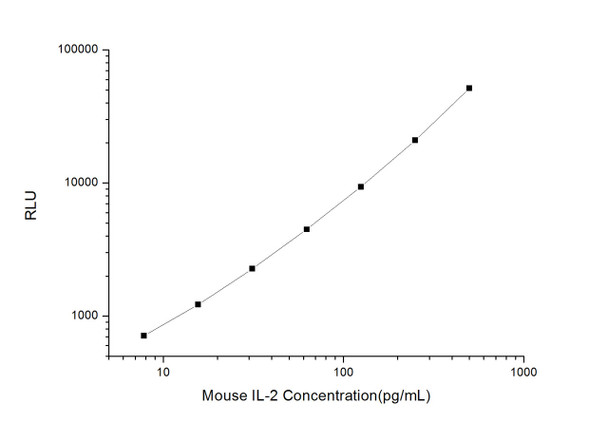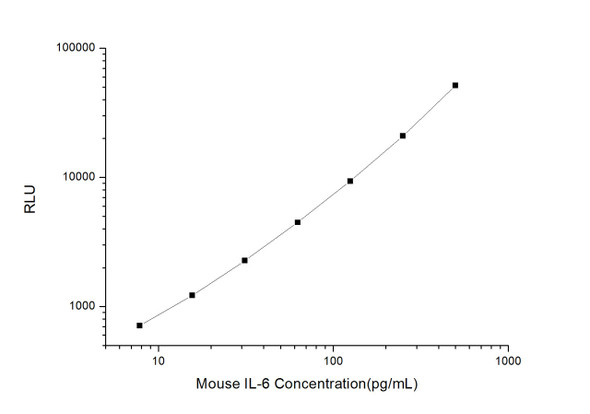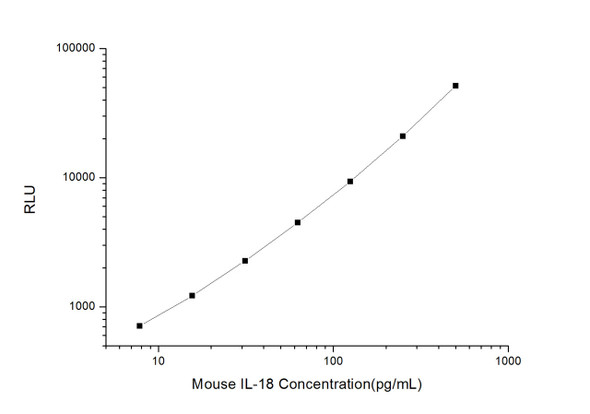Mouse Immunology ELISA Kits
Mouse IL-2 CLIA Kit (MOES00039)
- SKU:
- MOES00039
- Product Type:
- ELISA Kit
- ELISA Type:
- CLIA Kit
- Size:
- 96 Assays
- Sensitivity:
- 4.69pg/mL
- Range:
- 7.81-500pg/mL
- ELISA Type:
- Sandwich
- Synonyms:
- IL2, TCGF, Lymphokine
- Reactivity:
- Mouse
- Sample Type:
- Serum, plasma and other biological fluids
- Research Area:
- Immunology
Description
| Assay type: | Sandwich |
| Format: | 96T |
| Assay time: | 4.5h |
| Reactivity: | Mouse |
| Detection method: | Chemiluminescence |
| Detection range: | 7.81-500 pg/mL |
| Sensitivity: | 4.69 pg/mL |
| Sample volume: | 100µL |
| Sample type: | Serum, plasma and other biological fluids |
| Repeatability: | CV < 15% |
| Specificity: | This kit recognizes Mouse IL2 CLIA Kit in samples. No significant cross-reactivity or interference between Mouse IL2 CLIA Kit and analogues was observed. |
This kit uses Sandwich-CLIA as the method. The micro CLIA plate provided in this kit has been pre-coated with an antibody specific to Mouse IL2. Standards or samples are added to the appropriate micro CLIA plate wells and combined with the specific antibody. Then a biotinylated detection antibody specific for Mouse IL2 and Avidin-Horseradish Peroxidase (HRP) conjugate are added to each micro plate well successively and incubated. Free components are washed away. The substrate solution is added to each well. Only those wells that contain Mouse IL2, biotinylated detection antibody and Avidin-HRP conjugate will appear fluorescence. The Relative light unit (RLU) value is measured spectrophotometrically by the Chemiluminescence immunoassay analyzer. The RLU value is positively associated with the concentration of Mouse IL2. The concentration of Mouse IL2 in the samples can be calculated by comparing the RLU of the samples to the standard curve.
| UniProt Protein Function: | IL2: Produced by T-cells in response to antigenic or mitogenic stimulation, this protein is required for T-cell proliferation and other activities crucial to regulation of the immune response. Can stimulate B-cells, monocytes, lymphokine- activated killer cells, natural killer cells, and glioma cells. A chromosomal aberration involving IL2 is found in a form of T-cell acute lymphoblastic leukemia (T-ALL). Translocation t(4;16)(q26;p13) with involves TNFRSF17. Belongs to the IL-2 family. |
| UniProt Protein Details: | Protein type:Secreted, signal peptide; Secreted; Oncoprotein; Cytokine Cellular Component: cytosol; extracellular region; extracellular space Molecular Function:carbohydrate binding; cytokine activity; glycosphingolipid binding; growth factor activity; interleukin-2 receptor binding; kappa-type opioid receptor binding Biological Process: adaptive immune response; elevation of cytosolic calcium ion concentration; G-protein coupled receptor protein signaling pathway; immune response; immune system process; negative regulation of B cell apoptosis; negative regulation of heart contraction; negative regulation of inflammatory response; negative regulation of lymphocyte proliferation; negative regulation of protein amino acid phosphorylation; positive regulation of activated T cell proliferation; positive regulation of B cell proliferation; positive regulation of immunoglobulin secretion; positive regulation of interferon-gamma production; positive regulation of interleukin-17 production; positive regulation of isotype switching to IgG isotypes; positive regulation of protein amino acid phosphorylation; positive regulation of regulatory T cell differentiation; positive regulation of T cell differentiation; positive regulation of T cell proliferation; positive regulation of transcription from RNA polymerase II promoter; positive regulation of tyrosine phosphorylation of Stat5 protein; protein kinase C activation; regulation of T cell homeostatic proliferation; response to ethanol |
| UniProt Code: | P04351 |
| NCBI GenInfo Identifier: | 124326 |
| NCBI Gene ID: | 16183 |
| NCBI Accession: | P04351. 1 |
| UniProt Secondary Accession: | P04351,P97945, Q791T3, |
| UniProt Related Accession: | P04351 |
| Molecular Weight: | 19,400 Da |
| NCBI Full Name: | Interleukin-2 |
| NCBI Synonym Full Names: | interleukin 2 |
| NCBI Official Symbol: | Il2 |
| NCBI Official Synonym Symbols: | Il-2 |
| NCBI Protein Information: | interleukin-2 |
| UniProt Protein Name: | Interleukin-2 |
| UniProt Synonym Protein Names: | T-cell growth factor; TCGF |
| Protein Family: | Interleukin |
| UniProt Gene Name: | Il2 |
| UniProt Entry Name: | IL2_MOUSE |
As the RLU values of the standard curve may vary according to the conditions of the actual assay performance (e. g. operator, pipetting technique, washing technique or temperature effects), the operator should establish a standard curve for each test. Typical standard curve and data is provided below for reference only.
| Concentration (pg/mL) | RLU | Average | Corrected |
| 500 | 48740 54334 | 51537 | 51508 |
| 250 | 20200 21796 | 20998 | 20969 |
| 125 | 9644 9148 | 9396 | 9367 |
| 62.5 | 4284 4740 | 4512 | 4483 |
| 31.25 | 2352 2246 | 2299 | 2270 |
| 15.63 | 1260 1240 | 1250 | 1221 |
| 7.81 | 698 782 | 740 | 711 |
| 0 | 29 29 | 29 | -- |
Precision
Intra-assay Precision (Precision within an assay): 3 samples with low, mid range and high level Mouse IL2 CLIA Kit were tested 20 times on one plate, respectively.
Inter-assay Precision (Precision between assays): 3 samples with low, mid range and high level Mouse IL2 CLIA Kit were tested on 3 different plates, 20 replicates in each plate.
| Intra-assay Precision | Inter-assay Precision | |||||
| Sample | 1 | 2 | 3 | 1 | 2 | 3 |
| n | 20 | 20 | 20 | 20 | 20 | 20 |
| Mean (pg/mL) | 26.70 | 76.66 | 200.94 | 28.08 | 73.61 | 214.66 |
| Standard deviation | 2.52 | 5.41 | 21.42 | 2.72 | 6.12 | 18.61 |
| C V (%) | 9.44 | 7.06 | 10.66 | 9.69 | 8.31 | 8.67 |
Recovery
The recovery of Mouse IL2 CLIA Kit spiked at three different levels in samples throughout the range of the assay was evaluated in various matrices.
| Sample Type | Range (%) | Average Recovery (%) |
| Serum (n=5) | 94-107 | 101 |
| EDTA plasma (n=5) | 91-102 | 96 |
| Cell culture media (n=5) | 95-107 | 100 |
Linearity
Samples were spiked with high concentrations of Mouse IL2 CLIA Kit and diluted with Reference Standard & Sample Diluent to produce samples with values within the range of the assay.
| Serum (n=5) | EDTA plasma (n=5) | Cell culture media (n=5) | ||
| 1:2 | Range (%) | 98-112 | 93-106 | 91-104 |
| Average (%) | 105 | 99 | 97 | |
| 1:4 | Range (%) | 85-97 | 90-105 | 84-97 |
| Average (%) | 92 | 97 | 91 | |
| 1:8 | Range (%) | 91-107 | 98-116 | 100-114 |
| Average (%) | 98 | 106 | 108 | |
| 1:16 | Range (%) | 90-102 | 90-106 | 91-104 |
| Average (%) | 95 | 98 | 98 |
An unopened kit can be stored at 4°C for 1 month. If the kit is not used within 1 month, store the items separately according to the following conditions once the kit is received.
| Item | Specifications | Storage |
| Micro CLIA Plate(Dismountable) | 8 wells ×12 strips | -20°C, 6 months |
| Reference Standard | 2 vials | |
| Concentrated Biotinylated Detection Ab (100×) | 1 vial, 120 µL | |
| Concentrated HRP Conjugate (100×) | 1 vial, 120 µL | -20°C(shading light), 6 months |
| Reference Standard & Sample Diluent | 1 vial, 20 mL | 4°C, 6 months |
| Biotinylated Detection Ab Diluent | 1 vial, 14 mL | |
| HRP Conjugate Diluent | 1 vial, 14 mL | |
| Concentrated Wash Buffer (25×) | 1 vial, 30 mL | |
| Substrate Reagent A | 1 vial, 5 mL | 4°C (shading light) |
| Substrate Reagent B | 1 vial, 5 mL | 4°C (shading light) |
| Plate Sealer | 5 pieces | |
| Product Description | 1 copy | |
| Certificate of Analysis | 1 copy |
- Set standard, test sample and control (zero) wells on the pre-coated plate and record theirpositions. It is recommended to measure each standard and sample in duplicate. Note: addall solutions to the bottom of the plate wells while avoiding contact with the well walls. Ensuresolutions do not foam when adding to the wells.
- Aliquot 100 µL of standard solutions into the standard wells.
- Add 100 µL of Sample / Standard dilution buffer into the control (zero) well.
- Add 100 µL of properly diluted sample (serum, plasma, tissue homogenates and otherbiological fluids. ) into test sample wells.
- Cover the plate with the sealer provided in the kit and incubate for 90 min at 37 °C.
- Aspirate the liquid from each well, do not wash. Immediately add 100 µL of BiotinylatedDetection Ab working solution to each well. Cover the plate with a plate seal and gently mix. Incubate for 1 hour at 37 °C.
- Aspirate or decant the solution from the plate and add 350 µL of wash buffer to each welland incubate for 1-2 minutes at room temperature. Aspirate the solution from each well andclap the plate on absorbent filter paper to dry. Repeat this process 3 times. Note: a microplatewasher can be used in this step and other wash steps.
- Add 100 µL of HRP Conjugate working solution to each well. Cover with a plate seal andincubate for 30 min at 37 °C.
- Aspirate or decant the solution from each well. Repeat the wash process for five times asconducted in step 7.
- Add 100 µL of Substrate mixture solution to each well. Cover with a new plate seal andincubate for no more than 5 min at 37 °C. Protect the plate from light.
- Determine the RLU value of each well immediately.






